| . 1 . 2 . >> |
| Author |
Message |
jaransont3
Member
|
# Posted: 7 Jan 2013 07:13pm - Edited by: jaransont3
Reply
Here is my proposed plan for our small (420 sq ft) cabin in Northern MN.
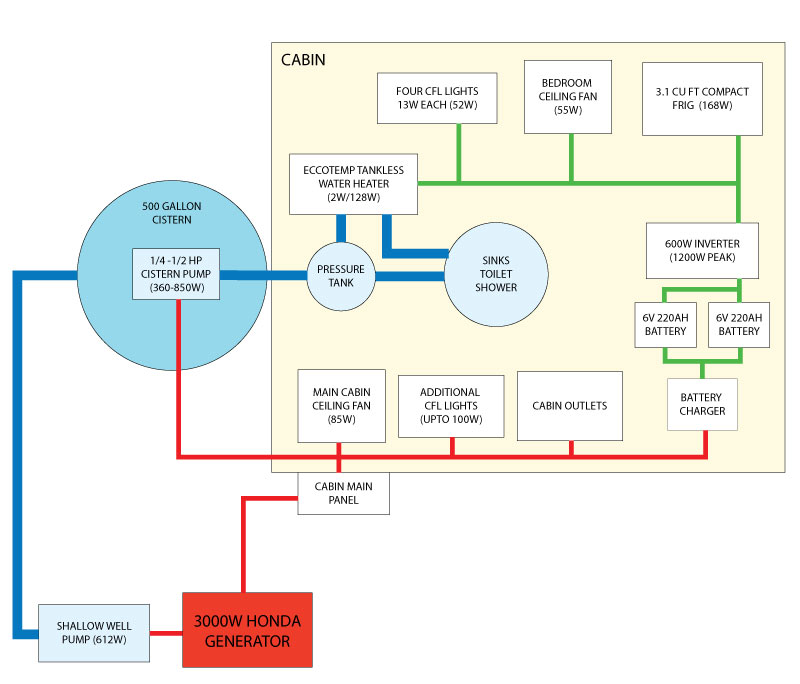
We don't mind running off the generator while we are awake and at the cabin. It is a Honda inverter generator and is very quiet. Plus it will be remote from the cabin in a separate shed. We only spend 2-4 weeks per year, a week at a time, at the cabin right now and the fuel costs are reasonable enough.
However , I can not see running it through the night when the only thing that might need it is the occasional cycling of the frig, the 2W of idle power needed for the water heater, and a night time trip to the bathroom. Same goes if we are out and about for several hours...trip to town, canoeing, hunting, etc.
Thus the battery and inverter for some of those items. I figure the batteries would be topped off any time the generator is running and given those load requirements, easily give me 1/2 a day of autonomy, especially if the only thing on is the frig and the water heater.
Since the cistern pump is powered by the generator, we would have to rely on the pressure and water in the pressure tank for the occasional flush when on battery power.
As for the well AND cistern system, this is driven by the desire to have water available when we come in the middle of the winter when it is well below freezing. (no pun intended) The shallow well pump would only be run as needed to fill the cistern. Then daily needs would be met with the smaller cistern submersible pump. The cistern would be buried and insulated to prevent it from freezing. This way we can fill the cistern at the end of our last visit in the summer or fall and winterize the shallow well pump and well to prevent it from freezing. Then use the cistern during our winter visit and fill it again when we arrive in the spring or summer.
What do you think of the plan? Recommendations and comments welcome...especially with regards to type and brand of inverter.
|
|
Dillio187
Member
|
# Posted: 8 Jan 2013 08:25am
Reply
I doubt the 600 watt inverter will be sufficient to start your refrigerator. The compressor needs significantly higher wattage to kick itself over and start. It will also significantly draw down a 220ah 12 volt bank over the course of the night. You will want to get a battery monitor and keep a close eye on them. You might want to consider going to a 24V bank to start with which will double your capacity and not require the use of expensive renewable energy batteries.
|
|
rayyy
Member
|
# Posted: 8 Jan 2013 08:44am
Reply
Well thought through plan to me, J3.A simular set up has worked very well for me.Be sure all your plumbing design's are able to be drained down for unoccupied winter time.For your P-trap's,remember to drain them or put down some RV antifreeze.Use LED light bulbs for any application's out side.(led 's are not affected by cold).I am curious about you water heater. Being propane mine doesn't need any outside power supply,but maybe the bigger ones do?What do you plan on using for heat?
|
|
jaransont3
Member
|
# Posted: 8 Jan 2013 04:57pm
Reply
Quoting: rayyy I am curious about you water heater. Being propane mine doesn't need any outside power supply,but maybe the bigger ones do?What do you plan on using for heat?
We are planning to use the Eccotemp FVI12-LP heater. It is vented and can be mounted inside the cabin. I suspect that the 2W idle power need is for the ventilation fan to prevent any build-up of combustible gas. The higher running power need is the vent fan running at higher speed to vent the combustion gasses from heating the water.
We have a propane cook stove and an old cast iron wood burner for heating the cabin.


We will be sure nad design the plumbing for easy draining. Thanks.
|
|
Rob_O
|
# Posted: 8 Jan 2013 06:31pm
Reply
Here's the first things that come to mind...
Get two more batteries to extend your reserve time
A couple hundred watts of solar panels will significantly extend your "quiet time"
Using a 12V shurflo RV pump on your cistern will allow you to use the water without running the generator
I'd also be inclined to use a transfer switch to take all the loads off the battery bank when the genset is running.
Hope that helps...
|
|
MtnDon
Member
|
# Posted: 8 Jan 2013 08:01pm - Edited by: MtnDon
Reply
In my experience a pump like a Shurflo or the equivalent Flojet will either perform poorly when asked to lift water several feet as with a buried tank, or may not even perform at all. A pump like a submersible Rule IL can do the job. We have one.
Rule IL200 or Rule IL500. Those are 12 VDC. There are other models and other voltages too. The GPH rating is maximum at zero head so the performance falls the higher the overall lift. The 200 will work well enough to a 10 foot overall lift. Not real fast at that.... not enough for a shower, IMO. I believe Grainger sells them as well and lists the complete specs for them.
I ditto the need for more battery capacity and some PV modules, unless there is very low solar potential. But even then a small amount of PV power will maintain the battery charge between uses. Lead acid batteries self discharge enough that leaving them for a month is not good for getting the longest life from them.
Does the fridge you are looking at use a compressor or one of the electronic peltier effect coolers? And how much power do they actually use in a typical days use? The electronic type do not have the motor start surge but are less efficient.
And as far as the buried cistern goes, the entire thing needs to be below frost depth if you want to be sure of it not freezing on the water surface in the tank. How do I know? Our tank should be a foot deeper; the upper water level is not below frost depth and it has frozen when mostly full and the weather turns very cold.  I have a work around but it is a pita. I have a work around but it is a pita.
|
|
MtnDon
Member
|
# Posted: 9 Jan 2013 12:04am
Reply
Just realized I forgot something important. The Rule pumps work well as a transfer pump; move water from here to there. They are not pressure pumps. We use ours to move water from the in ground cistern to the small under counter tank in the cabin. From there a Shurflo supplies pressurized water to sink, shower, water heater....
It is a submersible pump and ours lays in the cistern bottom with a half inch hose pushing water to the cabin whenever we turn it on. There is no check valve so water in the hose drains back into the cistern when the pump is off. This is good in cold weather.
|
|
jaransont3
Member
|
# Posted: 9 Jan 2013 08:51pm - Edited by: jaransont3
Reply
Thanks for the comments and input so far. Much appreciated.
Quoting: MtnDon I ditto the need for more battery capacity and some PV modules, unless there is very low solar potential. But even then a small amount of PV power will maintain the battery charge between uses. Lead acid batteries self discharge enough that leaving them for a month is not good for getting the longest life from them.
Our cabin is in extreme Northern MN and in a small clearing surround by tall trees. Not much PV potential there I suspect. We are only looking for maybe 6-10 hours of battery power per day...just while we are sleeping or away from the cabin for extended periods of time. Power consumption during these time will be extremely low. We will run the generator during the day and evening and let it recharge the batteries.
I have corrected the power schematic above. The frig is only a 3.1 cu ft model, non frost free. Mis-remembered that one. Peak motor amps are only 1.4 for the 168W running. Can't imagine that an inverter with a 1200W peak and 600W continuous rating can't start that...unless of course it doesn't meet the specified rating.
A transfer switch as was mentioned might be a good idea. Will look into that.
Quoting: MtnDon And as far as the buried cistern goes, the entire thing needs to be below frost depth if you want to be sure of it not freezing on the water surface in the tank.
I have put together a schematic for our cistern system too.
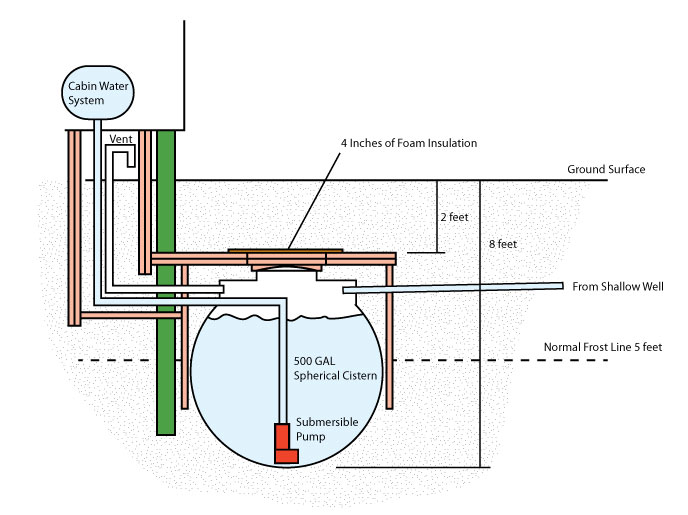
Everything I have read puts 1" of foam equivalent to 12" of depth/soil, so this should put the top of the cistern about 6 "feet" down and below the frost line with out burying the tank too deep. The feed line to the cabin would also be in an insulated run and chase up to the cabin floor. The feed from the shallow well pump would be sloped to drain into the cistern and wouldn't be used during frozen visits.
Just need to figure out the best pump or pumps to feed the cabin. Maybe a small holding tank inside the cabin with an RV high pressure, on-demand pump for the fixtures would be the way to go. Then I could use a relatively inexpensive lift (sump) pump to fill the holding tank from the cistern.
Keep the suggestions and input coming. We really do appreciate it.
|
|
|
jaransont3
Member
|
# Posted: 14 Jan 2013 11:37pm
Reply
A few modifications to the above water supply plan...
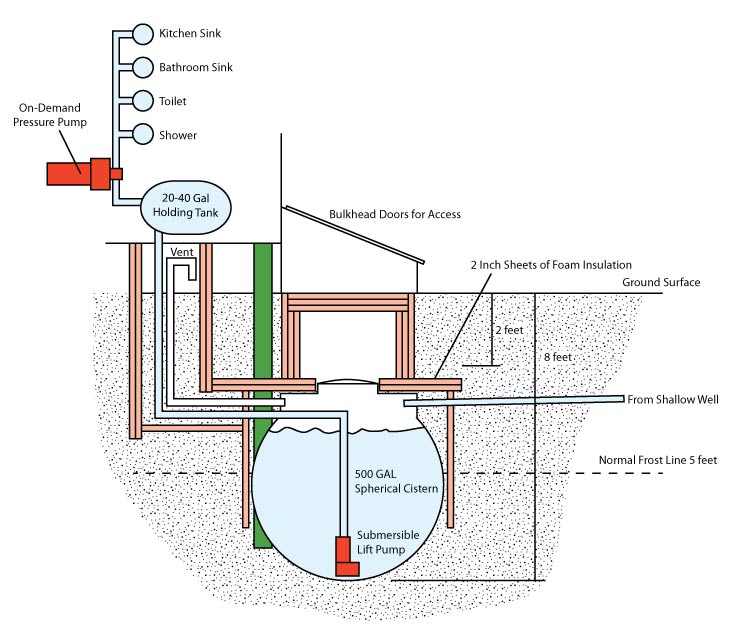
I am thinking that I will have a float switch in the holding tank that will activate the lift pump in the cistern when needed. The cistern will have a low level switch that shuts it off so the pump doesn't run dry and also trips an indicator light in the cabin. The filling of the cistern will be manually controlled using the shallow well pump. This way I can be sure that the generator is running for the shallow well pump.
The cistern will only need to be filled once per visit. The holding tank one to two times each day depending on usage and what size I end up with.
The on-demand pressure pump will be 12V and tied directly to the battery bank. It can then run anytime, independent of the generator. Will just be sure to fill it before we shut the generator off at night.
I also added the bulkhead doors for access to the cistern if needed. Maybe fill the space above the cistern and under the foam cover with foam or fiberglass batts (something easy to remove) to make sure it doesn't freeze. Sure a bunch easier to access then digging dirt to access the top of the cistern.
What do you think?
|
|
jaransont3
Member
|
# Posted: 25 Jan 2013 06:48pm - Edited by: jaransont3
Reply
OK, I have been searching the web and reading RV and Boating Forums trying to learn from others with regard to inverters, chargers, and batteries and such.
This is what I am thinking right now for actual equipment for the plan I originally posted above.
Tripp-Lite Inverter/ Charger APS750 750W Continuous/1500W Peak. Built in 20 amp charger and transfer switch. PWM Sine Wave when on batteries.
TrippLite Inverter
With two (2) Duracell CG2 6V/212AH Batteries wired in series.
Duracell Batteries
ANyone have actually experience with either of these products? WHat do you think of them? Opinions and input always welcome.
Keep in mind that I am only looking for 6 to 8 hours of battery autonomy at night while we are sleeping or when we are away from the cabin for extended periods of time during the day.
The inverter would only be wired to the water heater, compact frig, water pump, and a few lights. Maybe the bedroom ceiling fan.
The rest of the day the generator will be running. The generator and batteries will both be transported back and forth to the cabin and not left there. We go for months at a time with out getting to the cabin (unfortunately) and I do not want to leave the batteries unmaintained for the period of time. Plus the generator is used for emergency power back at home.
The need for portability is one of the reasons for wanting to go with only 2 batteries rather than a larger batter bank.
Thanks.
|
|
Anonymous
|
# Posted: 25 Jan 2013 07:16pm
Reply
or hook up to electrial line nearby and dig a well
|
|
jaransont3
Member
|
# Posted: 25 Jan 2013 08:03pm
Reply
Quoting: Anonymous or hook up to electrial line nearby and dig a well
We looked into full-time electrical and it would be over $5000 to get the power to the cabin and then $250+ per year for just the minimum monthly charge to have it there. We only get to spend 3-4 weeks per year at the cabin a week at a time.
For an investment of around $3000 we are off-grid at the cabin and have 3000W of generator power available at home for outages the other 48 weeks of the year. Granted we will burn 10-20 gals of gas in the generator each week we are there, but that is about the same cost as the annual total of monthly bill for the full time electric.
We will have a shallow well sand point on site for water. Even with the cistern, the holding tank and the extra pumps, it will be cheaper than a drilled well.
|
|
jaransont3
Member
|
# Posted: 4 Feb 2013 12:45pm
Reply
Any feedback on the TrippLite inverter I mention in my post above? How about the overall plan in general? Any and all feedback appreciated. Thanks.
We are looking to purchase the batteries and inverter before our next trip back to the cabin at the end of March.
|
|
creeky
Member
|
# Posted: 15 Feb 2013 03:05pm
Reply
that looks really good. and that tripplite looks amazing. what a nice package and cheap! 400 bucks online for a sinewave inverter with charger and auto switch.
too bad you can't put in more solar. at least the honda will be relatively quiet.
|
|
jaransont3
Member
|
# Posted: 15 Feb 2013 06:34pm
Reply
Quoting: creeky tripplite looks amazing. what a nice package and cheap! 400 bucks online for a sinewave inverter with charger and auto switch.
The Tripplite that I linked to is a PWM Sine Wave inverter, not pure sine wave when it is on DC (battery) power. It will pass Pure SIne Wave through it when on the generator or grid, assuming that source is PSW.
Some of the wording on the online sites about this inverter are a bit confusing. It still seems like a really good deal and the reviews are mostly positive.
Will be ordering my next month.
|
|
creeky
Member
|
# Posted: 22 Feb 2013 01:39pm
Reply
really. bummer. I thought modified sine wave was MSW and PWM was a pure sine. turns out to be marketing speak. jeez.
Don't get a MSW. Too many things don't run (or don't run well) on msw for someone who lives off grid. It might be more expensive. but it's worth going pure sine.
if square wave is the model T, then msw is the late 70s auto. pure sine is a modern reliable car.
amazon has a 1000w sunforce pure sine for under 200. and you'll have to get a charger. maybe 150. and a transfer switch. dang.
So the Tripplite aps1012sw is still an option. at twice the price. 900 bucks!
|
|
jaransont3
Member
|
# Posted: 24 Feb 2013 11:07pm
Reply
Considering I still drive a 1966 VW Type 3 Squareback during the non-salt season here in MI, the MSW or PWM technology is probably appropriate. 
But, seriously, for our needs right now...3-4 weeks per year a week at a time and only for low load times (such as overnight) I think the Tripp-Lite Inverter/ Charger APS750 will serve us well.
Will let you all know after I have had some time with the unit.
|
|
jaransont3
Member
|
# Posted: 10 Mar 2013 01:51am
Reply
Ordered the Tripp-Lite APS750 tonight. Should be here before our next trip to the cabin at the end of the month. Just need to make a run to Sam's Club for the batteries next. Will report back on how it fairs once we have tried it out on this trip.
|
|
creeky
Member
|
# Posted: 11 Mar 2013 05:26pm
Reply
look forward to your report. looks like a good unit.
|
|
jaransont3
Member
|
# Posted: 20 Mar 2013 04:08pm
Reply
Tripp-Lite APS750 showed up via UPS the other day. Substantial unit. Out-of-the-box impression is good. The case is plastic, but seems very stout. It is heavy and has nice heavy duty cable connectors built in.
I also picked up a pair of the Duracell GC2 6V batteries last night at Sam's Club.
I am anxious to get the bits to the cabin next week and try them out. Going to pick-up a Kill-A-Watt to measure real energy needs. Will report back after initial use.
|
|
Anonymous
|
# Posted: 20 Mar 2013 10:14pm
Reply
I believe it is considered good practice to provide an overflow escape in the event that your float switch or such malfunctions. The vent might be appropriately sized for that, but would you want it to dump out inside the building footprint?
igor
|
|
jaransont3
Member
|
# Posted: 21 Mar 2013 12:24am
Reply
Here is the latest plan for the electrical system and water supply...
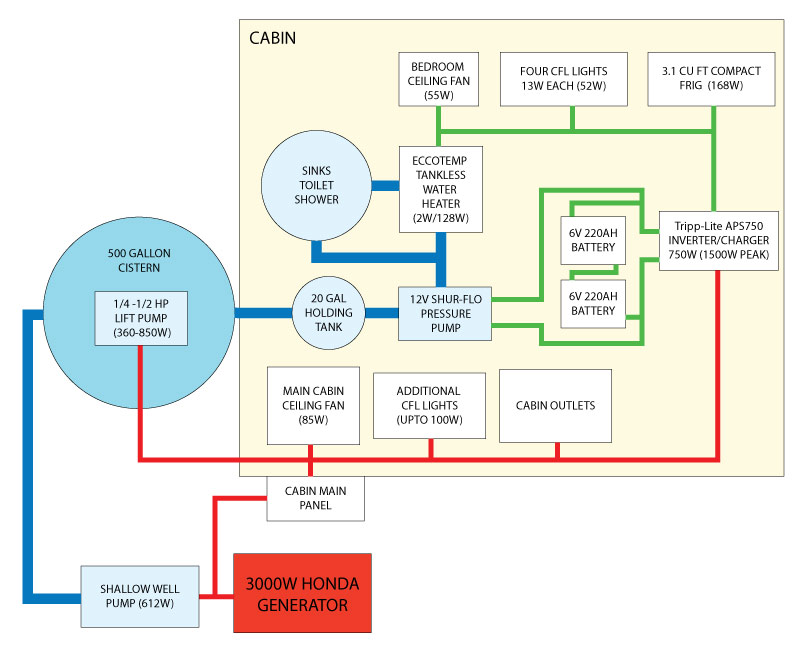
|
|
jaransont3
Member
|
# Posted: 3 Apr 2013 11:12pm
Reply
Time for an update on the power plan. Jill and I spent last week up at the cabin. My brother came out one day and rewired everything in the main panel and the inverter/batteries.
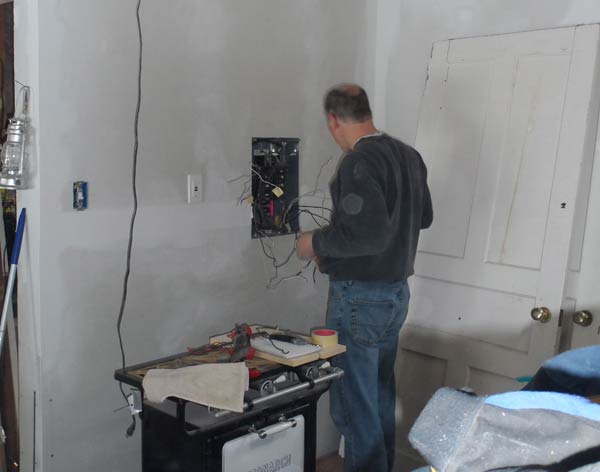
Some if it is still temporary.
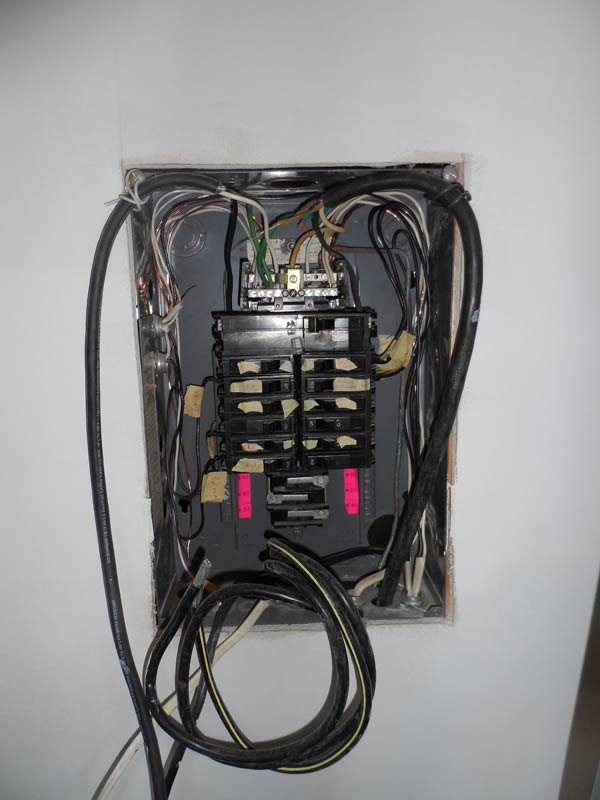
Next trip up we will hook the generator to the triplex and the triplex (at least one branch of it) to the panel. Right now we are just connected with a heavy duty extension cord. The inverter connection to the panel is also only temporary.
Obviously some of this is also temporary.
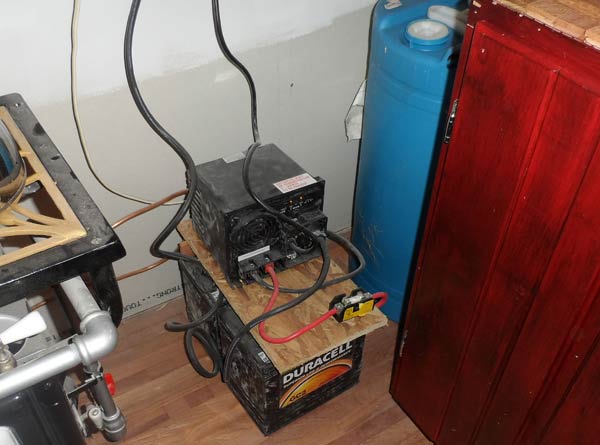
I brought the batteries and inverter back with me. I plan to build a box for them with carrying handles, battery hold-downs, a mounted fuse block and inverter. It will slide into a cabinet built into the kitchen with a simple plug-in connection to the panel.
The inverter powers one side of the panel and the generator the other. Only a few lights and outlights and the frig and water heater will be run off the inverter.
The inverter works great. It is completely silent when passing generator power through it. The transfer switch works flawlessly when you kill the generator. When it is in inverter mode there is a slight buzz. The fan does NOT run continuous. It all works great.......however.....
I do have to upgrade one component. I undersized the Class T fuse. It is only 30 amps. I read the rating for the AC side instead of the DC side. Duh-Oh! The 30 amp fused worked fine for the lights, but blew as soon as the frig tried to cycle on. We just put the frig on the generator side of the box for the time being.
I need to update to a 70 or 80 amp fuse, I think. The DC rating for the inverter is 72 amps. From my research, I think the 80 amp fuse would be a good choice. I am open to being better educated on this aspect of the system. Thoughts/suggestions?
Also, I see a bunch of folks using ANL fuses in this type of application. With my two battery/750W inverter, is this a good option? They are much cheaper than the Class T fuses.
Overall, I recommend the Tripp-lite!
|
|
CabinBuilder
Admin
|
# Posted: 4 Apr 2013 11:38am
Reply
Quoting: jaransont3 I need to update to a 70 or 80 amp fuse, I think. The DC rating for the inverter is 72 amps. From my research, I think the 80 amp fuse would be a good choice. I am open to being better educated on this aspect of the system. Thoughts/suggestions?
The initial short-term current spike at the start up of tools, etc. could easily double their rated operational current. Since class T fuses have instantaneous action, you will blow them often. They are really meant for quick protection against short circuits.
Also, you might be using 12V and other loads at the same time (in addition to the inverter).
Not clamming to be an expert, but I think you need higher amperage fuse. That's assuming your wires and other elements can handle the spike.
|
|
Alaskaman
Member
|
# Posted: 10 Apr 2013 03:06pm
Reply
Don't charge those batteries inside if you have a fire going in your woodstove. Hydrogen gas is a by-product. Goes BOOM!!
I went with sealed AGM's for that reason.
|
|
Alaskaman
Member
|
# Posted: 10 Apr 2013 03:10pm
Reply
I have a 300A/DC between my batteries and the inverter charger. I also am not an expert.
My plan is to put a manual disconnect after the fuse.
|
|
creeky
Member
|
# Posted: 11 Apr 2013 09:51am
Reply
Not sure why you would need a manual disconnect after the fuse to the inverter? When would you use it? If you want to turn off the power to the panel I imagine the inverter has an off switch.
I have a 500 amp Class T fuse that I paid too much for.
I did put in (eventually) a switch between the charge controller and the batteries. Got lucky. Found an old industrial motor switch with 2 DC rated lines. I can even set the amperage disconnect. 20 bucks at Habitat for Humanity. I've used it once or twice I think now. When adjusting the settings on the controller. Still. faster than unhooking the power lead...
|
|
jaransont3
Member
|
# Posted: 11 Apr 2013 11:43am
Reply
Quoting: Alaskaman Don't charge those batteries inside if you have a fire going in your woodstove. Hydrogen gas is a by-product. Goes BOOM!! I went with sealed AGM's for that reason.
Not at all concerned about the hydrogen outgassing from charging my two GC2 batteries. I was curious enough however to do a little digging in the internet. Found this site with some good basic information...
Hydrogen and Battery Charging
Based on the formulas there and the specs for my pair of GC2s, I would make about 0.7 cubic feet of hydrogen gas during an 8 hour charge cycle. Might seem like a lot, but our small 420 ft2 cabin has an internal volume of more than 4200 cubic feet with the open ceilings.
That results in a hydrogen concentration of only 0.017 percent. The recommendation on the site is to keep the concentration below 1-2%. That gives me a factor of safety of at least 60!
Add to this the fact that our cabin is certainly not airtight...far from it. And that fact that hydrogen is the lightest gas and dissipates very easily, I have zero concern about blowing the place up due to charging my two batteries.
I do appreciate the caution. It certainly should be something to consider with a much larger battery bank that might be contained in a smaller space. I will also be sure to include plenty of ventilation for the battery power box I plan to build for transporting the batteries and inverter.
|
|
Alaskaman
Member
|
# Posted: 11 Apr 2013 01:47pm
Reply
Thanks for the link.
I had a solar consultant out to my place yesterday. (adding panels this summer) He was very concerned that my bank was in my cabin. He said, "lots of things can go very bad very quickly and most end in explosion". 
|
|
Alaskaman
Member
|
# Posted: 11 Apr 2013 01:54pm
Reply
Quoting: creeky Not sure why you would need a manual disconnect after the fuse to the inverter? When would you use it? If you want to turn off the power to the panel I imagine the inverter has an off switch.
I was thinking of a manual disconnect so I can shut the power off to the inverter when I need to work on or rewire the inverter. Right now I have to unbolt the positive cable or unbolt the fuse. It's a PITA.
|
|
| . 1 . 2 . >> |

